|
This paper was presented at “The e-Government Conference†Conflux 2005 which took
place at The Grand, New Delhi from 17-19 October, 2005. The e-Government Conference
was jointly organized by Centre for Science, Development and Media Studies, GIS
Development Private Ltd and the Department of Information Technology, Government
of India.
-Susan Sharma, PhD
Founder, IndianWildlifeClub.com, Wildscapes.net and Wildbytes.tv
Abstract
With the Tiger Task Force having made its detailed report available in public domain,
the stage is now set for e-governance in the Ministry of Environment and Forests
(MOEF) to be attempted as an idea whose time has come. The paper looks at the need
to co-ordinate and link existing Information Systems (IS) regarding conservation
issues in India as a first step to arriving at a framework for e-governance. Throughout
the paper, we stress the fact that it is not hardware and software that makes e-governance
possible- but management and organization.
This concept paper is thus divided into linking together existing data on conservation,
re engineering the functionalities of MOEF and creating a framework for e-governance
taking into account the ministry, forest department, research organizations and
NGOs.
Conservation issues affect the core economy of any country. Conservation involves
protecting the forests of the country along with the flora and fauna as forests
are the custodians of water sources, clean air and irreplaceable natural resources.
The way these precious assets are managed will have a bearing on the country's revenues
(tourism, mining), well being (clean air and water) and social equity (tribal rights,
exploitation). The paper proposes a model where the synergies of a complex e-governance
system generate livelihood options for the rural unemployed in and around the forests.
These options are by way of entrepreneurship opportunities and not by way of government
jobs.
Key Words: e-governance, Information Systems, e-democracy
Contextual Background
India is the only country in the world where the magnificent Bengal Tiger roams
free in the wild. The onus of protecting this flagship species in the wild is with
the people of India , in particular with India 's chief environmental guardian,
the Ministry of Environment and Forest . In an effort to secure a safe haven for
the tiger in the wild, the Government of India declared 28 tracts of forests as
tiger reserves since 1972, when the Project Tiger initiative was undertaken by the
government. The recent discovery that despite these efforts, the tiger numbers are
dwindling-mainly due to habitat destruction and poaching- has brought home serious
lapses in governance. At the same time it has raised questions about the democratic
aspect of governance. There is a felt need to expand the scope of governance to
include the participation of all the citizens whose lives are linked to the forests
and the need for ongoing consultations from those who study the forests, its flora
and fauna as a science. The road map to e-governance for conservation (of our natural
resources) is thus a combination of e-governance and e-democracy.
Since the inception of Project Tiger in the early 1970s, the country has consistently
invested in the protection and conservation of the tiger. The Tiger Task Force report
of August 2005 has reviewed the work done over the last 35 years in conservation,
especially conservation of tiger, and has advocated the following action points
to be taken up urgently. The tiger, being on top of the food chain is accepted universally
as a symbol of conservation for conserving the other flora fauna of the forests
where they live.
- Reinvigorate the institutions of governance
- Strengthen efforts geared towards protection of the tiger, checking poaching, convicting
wildlife criminals and breaking the international trade network.
- Expand inviolate spaces for the tiger by minimizing human pressure in these areas.
- Repair the relationships with the people who share the tiger's habitat by building
strategies of coexistence.
- Regenerate the forest habitats in the fringes of the tiger's protective enclaves
by investing in forest, water and grassland economies of the people.
The sum and substance of the above recommendations are embodied in the simple flow
chart diagram below.
Fig 1. Resource flow between different components of
conservation

Literature Review
Multiple case studies done in developed countries suggest that very few e-democracy
proposals survive the stage of formal political decision –making, to become e-government
projects to be implemented (Mahrer & Krimmer, 2005). The hesitant evolution of e-democracy
has been attributed to the “middleman paradox†which results in implicit and explicit
resistance to further development in this critical feature of e-government.
However India has already proved an exception to this finding in the huge success
of ‘e-rail' for train ticket booking which is an initiative at the national level
and the ongoing success stories of many grass root level e-governance initiatives
under public-private partnerships.
A developing country which has had democratic traditions guiding its growth, India
has a tremendous potential to increase “social capital†as the guiding spirit to
prosperity. The concept of social capital (Putnam, 1993 and Coleman, 1988) added
a social component to the traditional factors shaping economic growth and prosperity.
A more specific sub-component of the social capital is entrepreneurship capital.
The entrepreneurship capital of an economy or a society refers to the institutions,
culture, and historical context that is conducive to the creation of new firms.
This involves a number of aspects such as social acceptance of entrepreneurial behaviour
but of course also individuals who are willing to deal with the risk of creating
new firms and the activity of bankers and venture capital agents that are willing
to share risks and benefits involved.
India has a tremendous potential to increase social capital – to be more specific
entrepreneurship capital- to be on the road to economic and ecological prosperity.
A case study on computerization of the Income tax department (Kanungo and Gupta,
2004) provides a critique on the e-governance being attempted in a major citizen
centric department of the country. The researchers found evidence of limited benefits
(at the efficiency level) that have been provided by Information Technology (IT)
for the Department of Income Tax (DIT). However most of the problems and impediments
faced by DIT, in the context of IS effectiveness, have come in the form of softer
aspects like people-related and complementary investments like process improvements
and organizational restructuring.
They concluded that in most Government Departments in India , the notion of complementarities
and simultaneity has to necessarily operate.
A complementary investment in IS is one that will result in a pay off that is greater
than the pay off based on IS investment alone. Simultaneity refers to events that
are happening or existing or are done at the same time. IT enabled fast track organizational
effectiveness has proved a non starter in Indian conditions-especially in bureaucratic
organizations. The notion of simultaneity is appropriate in such cases. Advocates
of concurrent approaches to IT investments make the argument that it is possible
to simultaneously or concurrently change/ improve processes as well as introduce
or enhance the existing IT infrastructure and application portfolio. In the case
of departments like DIT, the study found that for IT to be effective, process investments
must take precedence over IT investments. To quote Sam Pitroda, Chairman, Knowledge
Commission “We are computerizing the left-overs of the British Raj. ……in e-governance
the biggest challenge for India is to redo all our processes. But that is the biggest
challenge for India today, because it means you have to rethink our entire governance-
relationships, roles, processes.†Large bureaucratic organizations should strive
for mature processes and then automate the mature processes. A minimum level of
governance has to be ensured before attempting to implement e-governance. It is
unreasonable to expect processes to mature and get automated concurrently.
Limitations of a predominantly top-down/technology centric policy-planning model
in India have been studied in detail by many researchers. An emergent complex systems
approach to e-governance ( Amity S.Pande, 2004) focuses on including all stake holders,
linkages and communication loops as part of the initial design considerations of
an e-governance system. The framework for e-governance in conservation suggested
in this paper draws from the aspects of a complex system perspective and open standards
with intuitive, multi language interfaces to establish a dynamically evolving, self-organizing
e-governance system.
E-government for Management of Reform Efforts
Many e-government applications are crisis –driven. While analyzing the computerization
of the DIT, Kanungo et.al ( 2004 ) made a crucial observation that IT based process
change is not a good idea when it comes to large government set-ups. In the corporate
sector, a larger degree of control is experienced and hence use of I.T can lead
process changes. In the case of the Institutions responsible for conservation in
the country, it is necessary to reengineer the present set-up on the lines suggested
in the latest task force report before attempting to implement a system. One of
the most fundamental policy issues confronting the MOEF is how to achieve a trade
off between decentralization and democracy. Before going into the need for achieving
this, it will be worthwhile to dwell briefly on two schools of current economic
thoughts-the “Solowâ€economy( Solow, 1956) and the “Romer†economy ( Romer, 1986).
If physical capital was at the heart of the Solow economy, knowledge capital replaced
it in the Romer economy. While the policy goals of economic growth remained relatively
unchanged, the Romer model reflected the emergence of a new emphasis on a strikingly
different policy mechanism, knowledge capital, involving very different policy instruments(
David B. Audretsch, 2001). Entrepreneurship is an endogenous response to opportunities
created. In a comprehensive study at the Max Planck Institute, it was found that
regions rich in knowledge generated a greater amount of entrepreneurial opportunities
than regions with impoverished knowledge. (Audretch et.al, 2005) Knowledge created
with one context and purpose spills over from the organization actually attempting
to commercialize that knowledge.
The rural information systems which form part of the complex e-governance we propose
for MOEF are self sustainable after the initial period of handholding is over.
The biggest threat to conservation in our country is habitat degradation prompted
by economic pursuits. The flow chart of the complex e-governance system we are proposing
will result in alternative employment for the unemployed-they will create jobs for
themselves by becoming entrepreneurs. Entrepreneurs who will help implement the
e-governance system and entrepreneurs who will seize the opportunities unleashed
by the e-governance system.
Fig.2. Flow Chart for a Complex E-government system for MOEFF
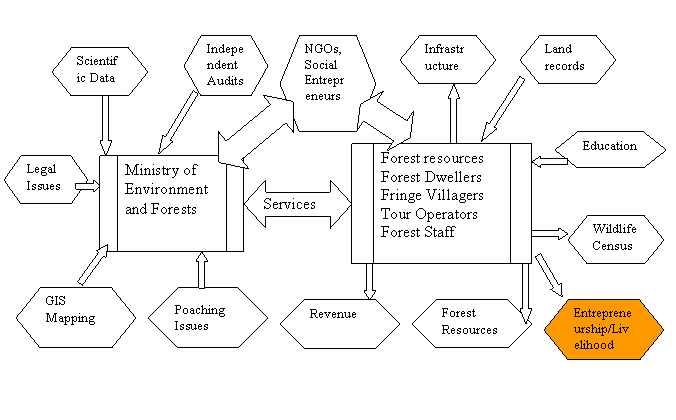
The above flow chart expands on fig.1 by substituting concepts of conservation with
the bodies responsible for it. The MOEF, as the Chief Environment Authority of the
land, is directly responsible for conservation of bio diversity. Its bundle of services
must include the major stakeholders, which are,
- Forest resources like water, trees, wild life etc
- The people who dwell in forests
- The villagers who are in the fringe of forests
- The tour operators who take the tourists into protected areas
- The Forest department staff.
We are proposing a complex system of bundled services involving personalized portals
for each of the major stakeholders. Interactions of the stakeholders with the various
agencies involved in conservation apart from MOEF have the potential of creating
employment within the complex system, thereby enriching it as well as taking it
forward. Most of the employment created, however will not be planned government
jobs but entrepreneurial in nature, born out of the synergy of rural information
systems.
Current Initiatives on E-Governance in India
One cannot deny the fact that Chief Environment Authority of the country is the
“Stateâ€. It thus becomes imperative to strengthen institutions at the Centre that
oversee conservation in the country. It becomes necessary to improve state capacities
and coax governmental institutions to involve local communities. The work relating
to conservation of bio-diversity in the country gets complicated due to the fact
that forest is also generating revenue for dependent communities. Conservation can
never really take off unless we can ensure alternate income sources for these villagers
and forest dwellers. The e-governance system proposed has within itself the seeds
for commercializing the knowledge base. A brief comparison of the successful e-governance
initiatives currently on in India supports this view.
Table 1. Initiatives in E-governance
|
Name & Year of starting
|
Brief details
|
States covered
|
Entrepreneurship potential
|
|
Gyandoot, 2000
|
Low cost rural intranet on optical fibre or UHF links.
In addition to agricultural produce and land records the kiosks have updated information
regarding beneficiaries of social security pension, beneficiaries of rural development
schemes, information regarding government grants given to village communities, public
distributions, data on families below the poverty line, etc.
|
Madhya Pradesh
|
User fees are charged for the services provided.
Rural youth as entrepreneurs
|
|
ITC's E-Choupal
|
Started as a cost- effective supply chain system to deal directly with the farmer
bypassing the middlemen in the Mandi. The ITC virtual mandi is emerging as a one
stop shop for selling and buying of all kinds of products and services including
government services in the rural market. Pradesh.
|
3800 villages in four states- which include Madhya Pradesh, Uttar Pradesh, Karnataka
and Andhra
|
ITC charges transaction fee and pays commission to kiosk owners for sales.
|
|
Amul's Dairy portal
|
Services offered include delivery of information related to dairying, including
best practices in breeding and rearing milch cattle, scheduling of government and
other private sector agency services, and collecting feedback on the quality of
service provided to the catchment area.. Use of a communication centre, Internet
banking services and ATMs which enable the milk societies to credit payments directly
to sellers bank accounts.
|
2500 milk co-operative societies are computerized- with each farmer holding a plastic
card id.
|
Electronic fat testing machines enable instant valuation of milk brought in by the
farmer and the banking infrastructure ensures instant payment to the farmer.
Access to a multimedia database on innovations captured by SRISHTI an NGO-from hundreds
of villages, covering agricultural practices, medicinal plants, home remedies, tools
and implements etc.
|
|
TARAhaat, 2000
|
Technology and Action for Rural advancement ( TARA ) brings relevant information,
products and services to rural market. Primarily a horizontal portal, with a super
bazzar on the net and information kiosks Goods ordered are delivered by franchised
TARA vans
|
U.P.
|
TV entertainment, public telephones and other offline services help generate a wider
range of revenue streams.
|
|
e- Shringala
|
The community information kiosks being set up in all the panchayats in Kerala. The
kiosks are designed to provide information of various schemes, downloading of applications,
farmer counseling.
|
Kerala
|
Kiosks owned and operated by entrepreneurs
|
|
e-Seva
|
The government portal is designed to the requirements of citizens providing information
and citizen's services. It has brought transparency in service delivery
|
Andhra Pradesh
|
Improved infrastructure and knowledge database giving rise to entrepreneurship.
Rural kiosks in West Godavari District are run by women self help groups.
|
|
"Parrys Corners"
|
The Agri portal of EID Parry, is an attempt to catalyze e-commerce in agricultural
and non-farm products by offering a network of partnerships. . .
|
Tamil Nadu
|
Sugar cane growers and suppliers to EID Parry encouraged to become entrepreneurs
|
A comparative analysis of the above projects shows that all projects are developmental
in nature and all are self sustaining. In all the above sited projects, the incentive
to develop new business models, services for rural consumers, and engage all members
of the e-governance system, is evident. The capacity limitations of stake holders
are generally overcome by the creative synergy and sharing that happens in a complex,
emergent e-governance system.
While Govt plays the role of facilitator and promoter in some, it is commerce that
drives e-governance in many cases. Some major lessons from these initiatives are
- Literacy is not a major constraint in implementing IT related projects. The rural
folks are quick to adopt any new developments.
- The government only needs to be a facilitator and not the promoter.
- It is not viable to have stand-alone e-governance projects. It makes sense to bundle
the same with community development, commerce and education.
- The projects can be self-sustaining. It is not necessary to fund them for long.
People are ready to pay for the services received through the kiosks and the same
should be enough to sustain and develop the project further.
- Make education an integral part of the initiative.
(M.J Xavier and RP Pillai, 2004)
The government-society-technology unit generates new sectors of activity, contexts
of use, and resource pools to survive. Anecdotic examples from Gujarat ( e-gram
panchayat) and Kerala ( Akshaya Project in Malappuram ) bear this as true. A Panchayat
of four villages in the Aravalis has started generating surplus revenue after being
a part of GSWAN ( Gujarat State Wide Area Network). Akshaya computer literacy program
initiated by the State Government has produced more than 600 entrepreneurs in a
sleepy village called Malappuram, in Kerala.
Proposed Conservation Model
In the conservation model we propose, there will be five “personalized internet
portals†for Forest Department, Forest Resources, Tour operators, Forest dwellers
and Fringe Villages . Each of these portals will have integrated service bundles
of both public administrations and enterprises connected to the MOEF. The integrated
service bundles are provided after the process integration of the involved service
suppliers is achieved with suitable technical interventions. A glance at the five
portals reveal two or three external influences which could prove contingent and
unpredictable but the majority of service loops are controllable. Customers of each
personalized portal have access to the bundled services. This kind of collaboration
leads to new synergies. New synergies often result in new revenue models and entrepreneurs
are born.
Figure 3. Personalized internet portal for the Forest Department
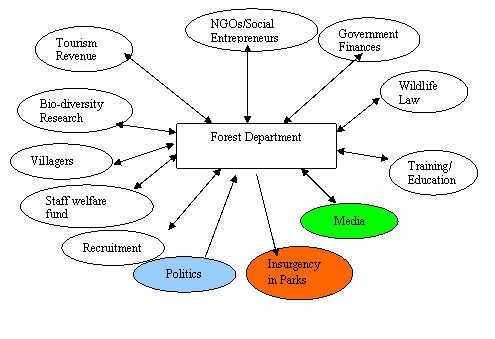
Figure 4. Personalized internet portal for Forest Resources
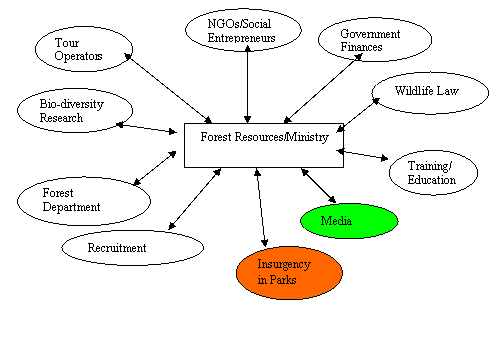
Figure 5. Personalized internet portal for the Forest Dwellers
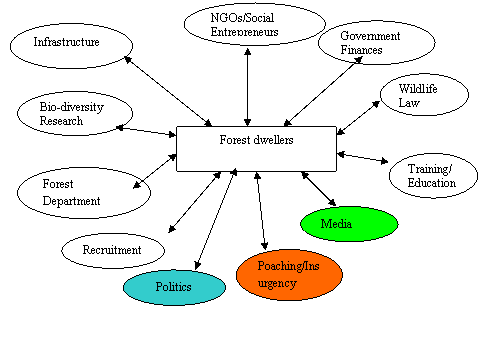
Figure 6. Personalized internet portal for the Tour Operators
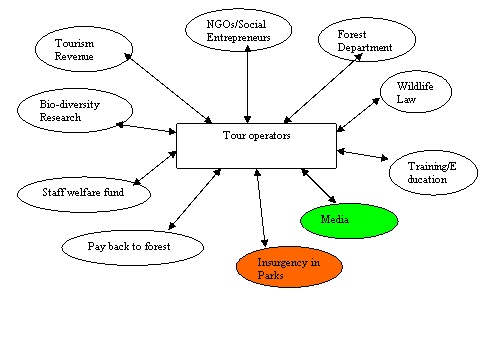
Figure 7. Personalized internet portal for the Fringe Villagers
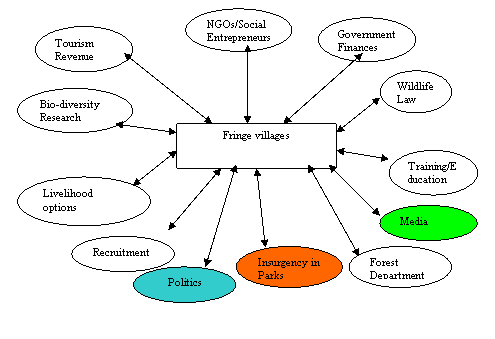
Maturity of E-governance Processes
E-governance projects mature in four phases, Information, Interaction. Transaction
and Transformation. This framework revolves around the citizen, NGOs on the one
side and the Central Government, State Government and Local Government on the other
side. The challenges for development are listed out in four major categories viz.
1. Political aspects include strategy and policy, laws and legislation, leadership,
decision-making process, funding issues and political stability.
2. Social aspects include people, education, employment, income, digital divide,
literacy and IT skills.
3. Economic aspects include funding, cost-savings, business models and e-commerce
and 4. Technological aspects include software, hardware, infrastructure, telecom,
IT skilled people, and maintenance, safety and security issues.
The aim of any e-governance project must be the fourth phase, that is, Transformation.
The Transformation effect must be the vision which drives any e-governance project.
Information, Communication Technologies (ICT) involved in any e-governance project
carries with it enormous potential for transforming poor people's lives (Gudgeon,
2001) connecting them to markets, improving their access to government services,
and better enabling them to express their voice in decisions that affect their lives.
The result of this transformation is creation of livelihood opportunities for entrepreneurs.
The rise and rise of entrepreneurship has paved the way for growth in countries
ranging from Taiwan to United States of America . Rural entrepreneurship has become
more a way of life and an engine for economic transformation among the rural poor
in Kenya ( Peter B. Kibas, 2005).
Capability building
E-governance projects need to employ a large number of personnel in handholding
which must continue till the projects are self sustaining. The aim of introducing
e-governance is not to reduce manpower but to achieve efficiency and transparency.
E-government can be effective only if internet is widely used. Otherwise manipulation
of the public and media by giving selected information, by taking things out of
context, will continue. The pervasive influence of e-government can be a reality
only if the backbone for e-commerce which is the internet is in place.
Many western countries have a citizenry majority of whom are already exposed to
internet. For them there is ‘nothing new†in e-governance. In fact it just fulfills
an expectation from the citizenry that Government services too- like many private
services –must become an extension of the backbone of internet one is familiar with
and used to.
The grass root reality in India , however is very different. Any movement associated
with e-government can expect results only after familiarizing the citizen with the
possibilities and capabilities of the internet.
The route for the development of e-governance follows the three-fold path of publish,
interact and transact models. In order to implement the later two, information handling
has to be changed from the traditionally used papers in the brick and mortar world,
to digital documents to be used in the new E-world. This leaves the government with
the Herculian task of restructuring its various organizations and to make them digitally
aware. The government must stick to its primary responsibility as a service provider
and delegate the responsibility of the interface provider to various private/public
sector corporate; entrepreneurs, web portals and citizens. These bodies can incorporate
such user interfaces to their existing and popular sites, thereby saving the efforts
of the government in bringing up and maintaining the required infrastructure. Such
a model would provide for a cost-effective solution for the deployment of e-governance
on the net.
Implementation
A collaborative platform from IBM India Research Lab , I.I.T Delhi
There are several issues involved in developing a complex application; some of them
are:
- Integrating applications: The e-governance applications that have been developed
and deployed in the past often address specific needs and provide isolated functionality.
In the case of MOEF there are several functions which are already computerized and
several databases which are already in existence. To harness the full potential
of e-governance, it should be possible to integrate these distributed applications
to create automated complex processes spanning multiple government departments and
institutions. However government applications implemented by multiple vendors are
difficult to integrate into a seamless solution. In order to ensure multi-vendor
support and modularity of the e-governance solution, the integration must be based
on open standards.
- Enabling ease of application management: Government processes are frequently modified
based on the changes in policies, work – realignment, etc. This requires identification
of possible modifications to business process or application logic that may be required
in future and creation of appropriate extension points in the application at the
time of application development. Further, since this reconfiguration process typically
needs to be carried out by a non-IT skilled official, a tool with intuitive interfaces
is needed to ease the application extension and modification.
- Enabling ease of use: Government applications are required to communicate with the
user in the user's preferred language, by means of intuitive graphical or conversational
interfaces. The Indian Government recognizes 18 languages for citizen –government
interactions. Interface consistency across applications is also desirable.
(Parul A. Mittal, Prasan Roy & Anupam Saronwala, 2004)
ICT based interventions run a high risk of failure unless macro and micro level
contingencies are inbuilt within the initial system design to reduce brittleness.
In the present scenario, individual stakeholders, such as a bureaucrat with an ideological
axe to grind, or a politician focused on the elections, can easily jeopardize the
success of e-governance. As with other complex systems, humans with conflicting
agendas are the weakest links in the e-governance system. (Amit S.Pande, 2004).
Positive and negative feedback loops built into the initial design encourage participation,
active involvement, critical questioning, sharing of data and better awareness among
all participants in an e-governance system. Let us now look at figure 8. given below.
The stakeholder service modules are the same as in figure2. But figure 8. presents
forward and backward linkages among the stakeholders represented by two- way block
arrows in the flow-chart. diagram. The possibilities of data generation and idea
generation multiply with such a system. The e-governance unit is able to organically
create and sustain their resources and their information needs. The various information
modules act as support systems for nurturing/creating livelihood opportunities.
In the absence of support measures, sweat shop strategy will be adopted by entrepreneurs.
( M. K Nair, 2005) the entrepreneurship firms generated by the complex system must
think of themselves as a cluster and explore potential benefits of close relationship
with other local organizations. There is collective efficiency in clusters.
The unused synergy potential of e-government through the integration of public and
private services can be used by the individual who is the information broker to
create an entrepreneurial business (Oner Gungoz, 2004)
Fig. 8 E-governance system with feedback loops ( forward and backward linkages)
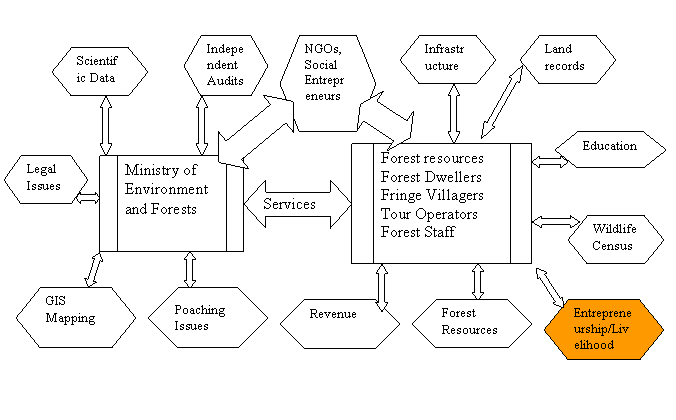
Concluding Remarks
This paper presents a case for creating a complex, emergent e-governance system
for MOEF. It focuses on including all stake holders, linkages and communication
loops as part of the initial design considerations. The rural information systems
which form part of the initial design, are projected as self-sustainable units after
the initial hand-holding period is over. The Government- Society-Technology unit
which forms the backbone of the e-conservation system is expected to throw up alternate
livelihood options for the rural unemployed among forest dwellers and fringe dwellers,
which are in the form of entrepreneurship opportunities.
The goal of conserving our forest resources and bio-diversity becomes more tangible
and participative.
References
- Amit S.Pande (2004) An Emergent Complex Systems Perspective on E-Governance Towards
E-Government , Management and Challenges, Edited by M.P Gupta, Tata McGraw –Hill
Publishing Company Ltd pp 237-246
- Audretsch, David B, (1995) Innovation and Industry Evolution, 1995, Cambridge :MIT
Press
- Audretsch, David B., Max Keilbach and Erik Lehman (2005), Entrepreneurship and Economic
Growth, New York : Macmillan
- Coleman, J.C.,(1988) Social Capital in the Creation of Human Capital American Journal
of Sociology (94), pp S95-S120
- Gudgeon, P.S. (2001). Globalization and Rural Poverty Reduction: The Role of the
United Nations System-Contrasting Styles and Competing Models, Expert Group Meeting
on Globalization and poverty Reduction: Can the Rural Poor Benefit from Globalization?
Organized by Division for Social Policy and Development, United Nations, 8-9 November
2001, New York .
- Harald Mahrer & Robert Krimmer ( 2005) Towards the enhancement of e-democracy: identifying
the notion of the ‘middleman paradox' Information Systems Journal Vol15 (1) Jan
2005
- Oner Gungoz ( 2004) E-Government meets E-Business-C-Government Towards E-Government
, Management and Challenges, Edited by M.P Gupta, Tata McGraw –Hill Publishing Company
Ltd pp 66-72
- Parul A. Mittal, Prasan Roy & Anupam Saronwala ( 2004) A Collaborative Platform
for Developing E-Governance Applications, Promise of E-Governance, Operational Challenges,
Edited by M.P Gupta, Tata McGraw –Hill Publishing Company Ltd pp 303-311
- Peter B. Kibas Rural Entrepreneurship in Kenya : Perception of Women on Entrepreneurship
ICSB World conference, Washington D.C June 15-18, 2005
- Putnam, Robert D(1993) Making Democracy Work Princeton : Princeton University Press
- Romer, Paul M(1986) Increasing Returns and Long-Run Growth Journal of Political
Economy 94(5), October, pp 1002-37
- Shivraj Kanungo ( 2004) Research Directions for Studying ICT Interventions in Poor
and Rural Areas in Developing Countries , Towards E-Government , Management and
Challenges, Edited by M.P Gupta, Tata McGraw –Hill Publishing Company Ltd pp 155-164
- Shivraj Kanungo, M.P Gupta and Rajesh Kumar( 2004) A Multi-Level Analysis of IT
Effectiveness, Promise of E-Governance, Operational Challenges, Edited by M.P Gupta,
Tata McGraw –Hill Publishing Company Ltd pp 220-233
- Solow, Robert (1956) A Contribution to the Theory of Economic Growth Quarterly Journal
of Economics Vol.70 pp 65-94
- Sukumaran Nair M.K Why do some clusters stagnate? Evidence from two resources based
clusters in Kerala , India ICSB 2005 World conference, Washington D.C June 15-18,
2005
- Xavier M.J and Pillai R.P Indian Experience on G2C Service Delivery Models: Select
Case Studies and Lessons for Future Developments Promise of E-Governance, Operational
Challenges, Edited by M.P Gupta, Tata McGraw –Hill Publishing Company Ltd pp 31-40
|